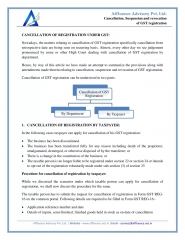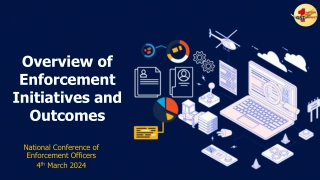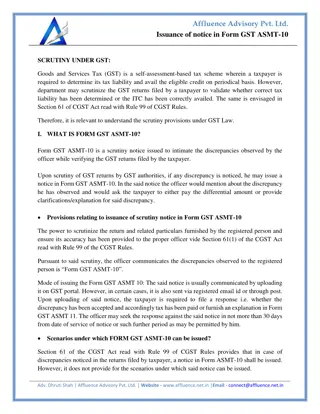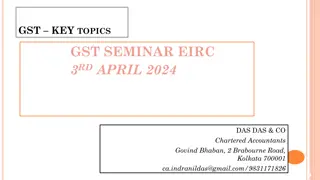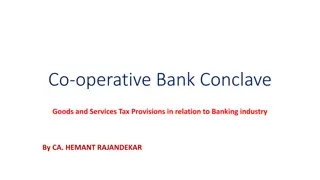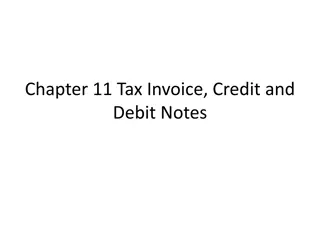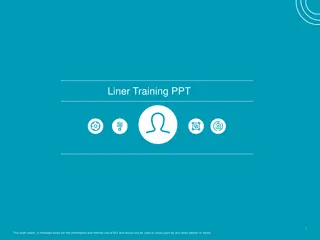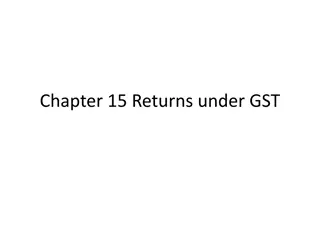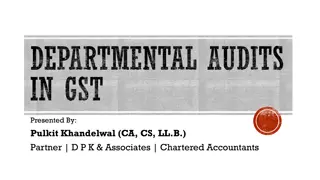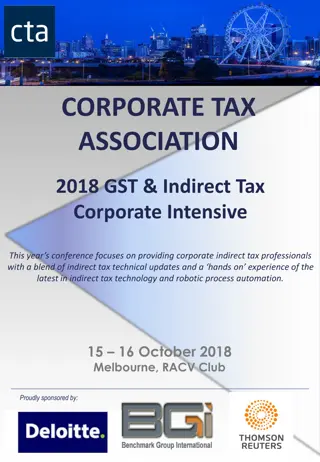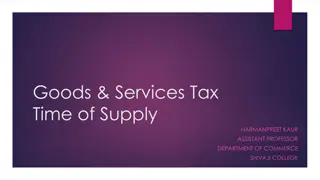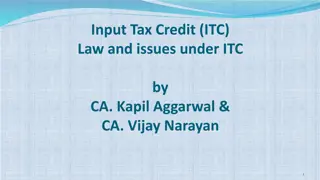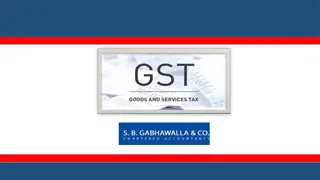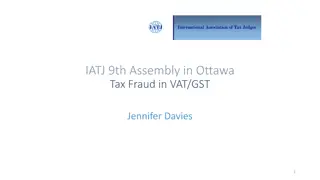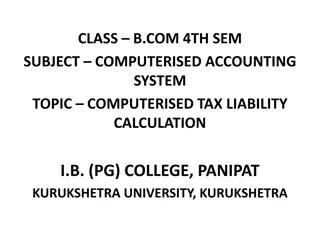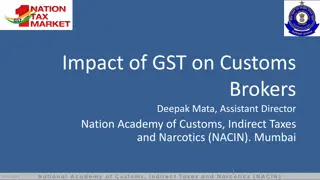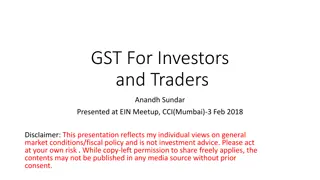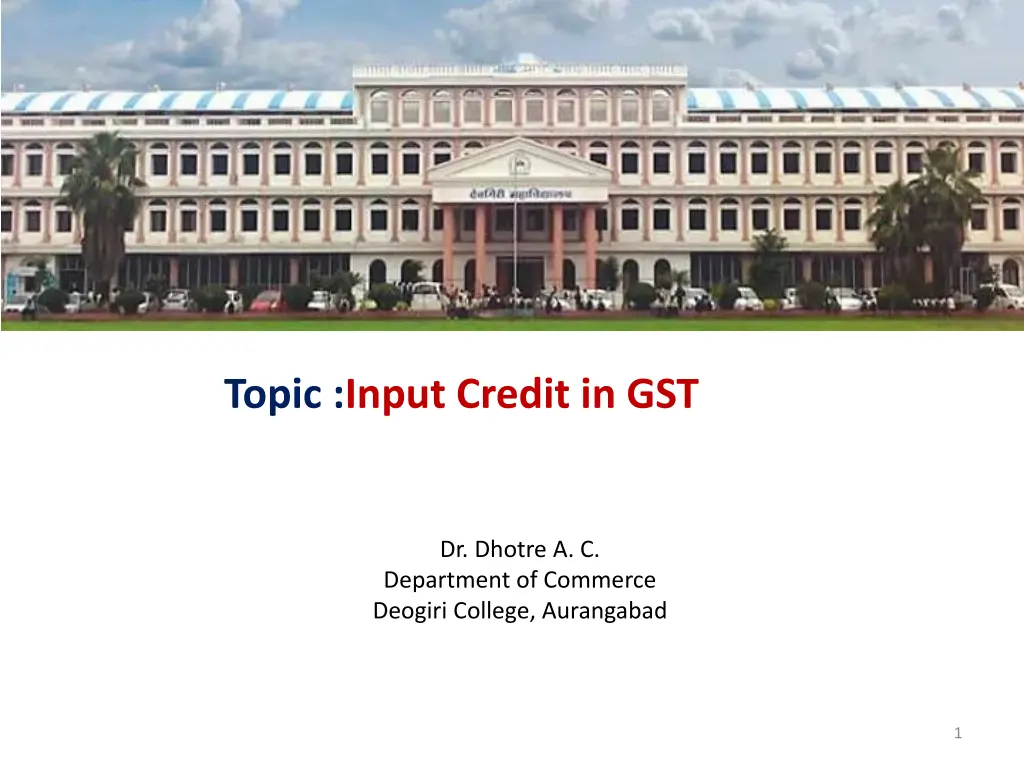
Understanding Input Credit in GST Mechanism
Learn about input tax credit in GST, a mechanism that allows you to reduce tax paid on inputs from tax payable on outputs. Explore how to claim input credit, requirements, and implications of unclaimed credit.
Download Presentation

Please find below an Image/Link to download the presentation.
The content on the website is provided AS IS for your information and personal use only. It may not be sold, licensed, or shared on other websites without obtaining consent from the author. If you encounter any issues during the download, it is possible that the publisher has removed the file from their server.
You are allowed to download the files provided on this website for personal or commercial use, subject to the condition that they are used lawfully. All files are the property of their respective owners.
The content on the website is provided AS IS for your information and personal use only. It may not be sold, licensed, or shared on other websites without obtaining consent from the author.
E N D
Presentation Transcript
Topic :Input Credit in GST Dr. Dhotre A. C. Department of Commerce Deogiri College, Aurangabad 1
Input Credit in GST Input Credit Mechanism is available to you when you are covered under the GST Act. Which means if you are a manufacturer, supplier, agent, e-commerce operator, aggregator or any of the persons mentioned here, registered under GST, You are eligible to claim INPUT CREDIT for tax paid by you on your PURCHASES.
What is Input tax credit Input credit means at the time of paying tax on output, you can reduce the tax you have already paid on inputs. Say, you are a manufacturer tax payable on output (FINAL PRODUCT) is Rs 450 tax paid on input (PURCHASES) is Rs 300 You can claim INPUT CREDIT of Rs 300 and you only need to deposit Rs 150 in taxes.
How to claim input credit under GST? To claim input credit under GST You must have a tax invoice(of purchase) or debit note issued by registered dealer Note: Where goods are received in lots/installments, credit will be available against the tax invoice upon receipt of last lot or installment. You should have received the goods/services Note: Where recipient does not pay the value of service or tax thereon within 3 months of issue of invoice and he has already availed input credit based on the invoice, the said credit will be added to his output tax liability along with interest.
How to claim input credit under GST? The tax charged on been deposited/paid to the government by the supplier in cash or via claiming input credit Supplier has filed GST returns Possibly the most path breaking reform of GST is that input credit is ONLY allowed if your supplier has deposited the tax he collected from you. So every input credit you are claiming shall be matched and validated before you can claim it. Therefore, to allow you to claim input credit on Purchases all your suppliers must be GST compliant as well. your purchases has
How to claim input credit under GST? There s more you should know about input credit It is possible to have unclaimed input credit. Due to tax on purchases being higher than tax on sale. In such a case, you are allowed to carry forward or claim a refund. If tax on inputs > tax on output > carry forward input tax or claim refund If tax on output > tax on inputs > pay balance
How to claim input credit under GST? No interest is paid on input tax balance by the government Input tax credit cannot be taken on purchase invoices which are more than one year old. Period is calculated from the date of the tax invoice. Since GST is charged on both goods and services, input credit can be availed on both goods and services (except those which are on the exempted/negative list). Input tax credit is allowed on capital goods. Input tax is not allowed for goods and services for personal use. No input tax credit shall be allowed after GST return has been filed for September following the end of the financial year to which such invoice pertains or filing of relevant annual return, whichever is earlier.
Documents Required for Input Credit The following documents are required for claiming ITC: 1. Invoice issued by the supplier of goods/services 2. The debit note issued by the supplier to the recipient (if any) 3. Bill of entry 4. An invoice issued under certain circumstances like the bill of supply issued instead of tax invoice if the amount is less than Rs 200 or in situations where the reverse charge is applicable as per GST law. 5. An invoice or credit note issued by the Input Service Distributor(ISD) as per the invoice rules under GST. 6. A bill of supply issued by the supplier of goods and services or both.
Who can Claim for ITC ITC can be claimed by a person registered under GST only if he full fills ALL the conditions as prescribed. a. The dealer should be in possession of tax invoice b. The said goods/services have been received c. Returns have been filed. d. The tax charged has been paid to the government by the supplier. e. When goods are received in instalments ITC can be claimed only when the last lot is received. f. No ITC will be allowed if depreciation has been claimed on tax component of a capital goods A person registered under composition scheme in GST cannot claim ITC.
What be claimed as ITC? ITC can be claimed only for business purposes. ITC will not be available for goods or services exclusively used for: a. Personal use b. Exempt supplies c. Supplies for which ITC is specifically not available 4. How to claim ITC? All regular taxpayers must report the amount of input tax credit(ITC) in their monthly GST returns of Form GSTR-3B.
Reversal of Input Tax Credit While paying taxes to the Government, businesses can use the credit of GST paid on the purchases like raw materials/services used for manufacturing or selling products. It is known as an Input tax credit (ITC). If the input tax credit is wrongly claimed, then it should be reversed by making payment to that extent next month.
What does reversal of ITC mean? In basic conditions for claiming ITC is satisfied, ITC claimed must be reversed. Reversal of ITC means the credit of inputs utilised earlier would now be added to the output tax liability, effectively nullifying the credit claimed earlier. Depending upon when such reversal is done, payment of interest may also be required. certain situations, even if the
Reversal of Input Tax Credit ITC can be availed only on goods and services for business purposes. If they are used for non-business (personal) purposes, or for making exempt supplies ITC cannot be claimed . Apart from these, there are certain other situations where ITC will be reversed. ITC will be reversed in the following cases- 1) Non-payment of invoices in 180 days ITC will be reversed for invoices which were not paid within 180 days of issue. 2) Inputs partly for business purpose and partly for exempted supplies or for personal use This is for businesses which use inputs for both business and non-business (personal) purpose. ITC used in the portion of input goods/services used for the personal purpose must be reversed proportionately.
Reversal of Input Tax Credit 3) Capital goods partly for business and partly for exempted supplies or for personal use This is similar to above except that it concerns capital goods. The details of reversal of ITC will be furnished in GSTR-3B.
ITC on inward supplies This is pertaining to 11.A.(a) Amount in terms of rule 37(2) in GSTR 2 As a dealer, you would have availed ITC on inward supplies. But if you fail to pay the invoice amount to the supplier within 180 days the ITC has to be reversed. If part of the invoice is paid the ITC will be reversed on a proportionate basis. For example Mr. A received goods on 1st July 2017 worth Rs. 10000 on which GST Rs. 1800 was charged. Mr. A claimed the GST of Rs 1800 as ITC in his GSTR 2 Mr. A could not pay the invoice amount till December 2017. This means that Mr. A will have to reverse the ITC of Rs 1800 while filing GSTR 2 for December 2017 in January 2018.
ITC on input supplies partly used for business and partly for exempt supplies or personal use This is pertaining to 11.A.(c) Amount in terms of rule 42(1)(m). The ITC used for exempt supplies and personal purpose has to be reversed in GSTR 2. How to Calculate ITC reversal on Exempt Supplies Step 1 Calculate Common Credit Common Credit = Total ITC on Input Supplies (less) ITC on supplies used for Personal purposes (less) ITC on supplies used for providing exempt supplies (less) ITC on which credit is not available (less) ITC on supplies other than exempted but including zero rated supplies (ITC on normal supplies) In simple words, Common Credit is ITC on inputs partly used for exempt supplies or personal use.
For Example Step 2 Amount of reversal of input tax credit attributable to inputs partly used for Exempt supplies = (Value of Exempt Supplies (25000)* Common Credit (4000) / Total Turnover in the State (100000) 25000*4000/100000 = 1000 (ITC on Exempted Supplies)
ITC on Capital Goods partly used for business and partly for exempt supplies or personal use This is pertaining to 11.A.(d) Amount in terms of rule 43(1)(h). ITC on capital goods used for the supply of exempt supplies and non-business purposes will also be reversed. The calculation will be similar to the calculation for ITC on inputs used for exempt supplies and personal use. Step 1 Calculate Common Credit Common Credit = ITC on Capital Goods (less) ITC on capital goods put to personal use (less) ITC on capital goods used for exempted goods (less) ITC on capital goods used in supplies other than exempted but including zero rated supplies (ITC on normal supplies)
For Example Step 2 Amount of ITC reversal attributable to capital goods partly used for Exempt supplies and Personal use = Value of Exempt Supplies (100000)* Common Credit (300000)/Total Turnover in the State (1000000) 100000*300000/1000000= 30000 Step 3 This reversal of input tax credit has to be done on a monthly basis. The life of any asset is considered as 5 years. So the amount of ITC reversal every month will be =Amount arrived at in Step 2 / 60 (months) 30000/60=500 The ITC to be reversed has to be added to output liability. Also, amount of ITC to be reversed should be further segregated into IGST, CGST, SGST and Cess
Credit note issued to ISD This is pertaining to 11.A.(b) Amount in terms of rule 39(1)(j)(ii). When an ISD receives a Credit Note from a supplier the ITC distributed previously has to be reversed. The dealers to whom the credit was distributed also have to reverse this ITC. This reversal of input tax credit shall be in the same proportion as in the original ITC distribution by the ISD. The ITC reversed has to be added to output liability.
For example M/s X receives services worth Rs 100000 on which GST of Rs 18000 was paid. M/s X distributed this credit to 2 dealers A and B in the ratio of 1:2 A and B claimed the ITC in the GSTR 2. Now M/s X has received a credit note worth Rs 23600 (including GST of Rs 3600) This GST of Rs 3600 has to be reversed by A & B in the ratio of 1:2 A will reverse ITC of Rs 1200 (3600 * 1 / 3) B will reverse ITC of Rs 2400 (3600 * 2 / 3) This will be included in the GSTR 2 by both A and B in the reversal of input tax credit section. Also, amount of ITC to be reversed should be further segregated into IGST, CGST, SGST and Cess.
Reversal of ITC on inputs used for exempted/non- business purpose is more than the ITC reversed during the year This is pertaining to 11.A.(e) Amount in terms of rule 42 (2)(a). After filing GSTR 9 Annual Return the total ITC on inputs used for non-business or exempt supplies can be more than the total ITC reversed during the year in the GSTR 2. In that case, the differential amount must be reversed in the GSTR 2. The difference will be added to output tax liability. This has to be mentioned in column 2. Also, amount of ITC to be reversed should be further segregated into IGST, CGST, SGST and Cess and entered in column 3, 4, 5 and 6.
ITC reversed during the year is more than ITC on inputs used for exempted / non- business purpose This is pertaining to 11.A.(f) Amount in terms of rule 42(2)(b). This is the opposite of the previous point. Either Pt.5 or Pt 6 will be applicable to you. In this case, the differential amount can be reclaimed as ITC. The amount should be reduced from output liability. The amount of ITC to be reclaimed has to be segregated into IGST, CGST, SGST and Cess.
Payment of ITC reversal added to Output Tax Liability This is pertaining to 11.(A).(g) On account of amount paid subsequent to reversal of ITC. All ITC reversals which increase output tax liability are required to be paid. Any payment made has to be mentioned in this point. The tax paid has to be categorised as IGST, CGST, SGST and Cess. Amendments to information regarding ITC reversal provided in earlier return This is pertaining to 11.(B) Amendment of information furnished in Table No 11 at S. No. A in earlier return. Since there is no option of revising GSTR 2 any amendments to be made to previous reversals has to be mentioned here.
Negative List of Input Tax Credit under GST Blocked Credit- No Benefit of ITC List Divide Broadly: Personal purpose Not for further sale For immovable property Towers and pipelines
Negative List of Input Tax Credit under GST MV and Conveyances Foods and beverages Memberships Rent a cab, insurances etc. Travel benefits to employees Works contract Inward supplies for construction
Negative List of Input Tax Credit under GST Composition Scheme NRTP-Non Resident Taxable Person (Ex. Exception - Goods Import Ex. Toolkit) only for goods not for services Personal Consumption (Ex. TVS Showroom) Lost, Stolen etc. Fraud Cases ex evasion of tax penalty paid on fraud taxes .
Negative List of Input Tax Credit under GST MV and Conveyances (Vessels and Aircrafts) Transport Goods Ex. School, GTA (Goods Transport Agency), Ex. Infosys, TCS, Purchased car for director of company Transport of passengers Ex. Taxi/cab, employees transfer inside not for business Aircraft for transport further supply of such goods Imparting Training Ex. Drivers purchased cars for travelling
Negative List of Input Tax Credit under GST Foods and beverages Ex. Fruits, Vegetables, Foods------ outward nature is same But Ex. Construction Company Food ---GST----secondary market Composite Supply: Ex. Airlines Company Sales Ticket with Food Outdoor catering Ex. Beauty treatment Ex. Film industry Health services Ex. Same nature of supply like hospital Cosmetic and plastic services Ex. (Face surgery, for patient from business angles) Except: I/W used for same category ..O/W Or as a part of composite or mixed supply
Negative List of Input Tax Credit under GST Membership ex. Company takes membership for employees health club, (1000000-100000) and it is added in the packages of employees no ITC Rent cab: ex construction companies takes taxi on rent= no ITC But only Cab rent business = ITC (Inward and Outward Supply Ex. Services --Insurance Company to Insurance Company But Insurance Company to Customer- No ITC
Negative List of Input Tax Credit under GST Travel benefits to employees Ex. (Employees Travel Ticket by Company) Work contract for construction of immovable property Ex. Work contractor rendered services of construction of a building = no ITC But Except: I/W used for same category ..O/W And ITC for Plant and Machinery(Movable)
Utilization of ITC under GST CGST Circular No. 98/17/2019 was issued on 23 April 2019 has clarified the order of ITC utilisation for each tax head. It further stated that until the new Rule 88A of the CGST Rules is implemented on the GST portal, taxpayers have to follow the facility available on the GST portal. Such facility was made available from July 2019 returns onwards.
Utilization of ITC under GST As per the provisions of Section 49 of the CGST Act, credit of integrated tax has to be utilised first for payment of integrated tax, then Central tax and then State tax, in that order mandatorily. This led to a situation, in certain cases, where a taxpayer has to discharge his tax liability on account of one type of tax (say State tax) through electronic cash ledger, while the input tax credit on account of other types of tax (say Central tax) remains unutilised in electronic credit ledger.
Utilization of ITC under GST The newly inserted rule 88A in the CGST Rules allows utilisation of input tax credit of integrated tax towards the payment of Central tax and State tax, or as the case may be, Union Territory tax, in any order subject to the condition that the entire input tax credit on account of integrated tax is completely exhausted first before the input tax credit on account of Central tax or State/Union Territory tax can be utilised.
Utilization of ITC under GST Input Tax Credit Example: Car (Maharashtra) Inputs from Maharashrta- Styring SGST- 2000 and CGST 2000 Inputs from Tamilnadu -Engineering services IGST- 10000 Inputs from MP - Purchased of tyre IGST- 6000 After Manufacturing- Output GST Liability- 25000 (IGST)
Manner of Utilization of ITC IGST (10000+6000)=16000 (ITC Available) CGST 2000 (ITC Available) SGST - 2000 (ITC Available) IGST (Output) 25000 Use IGST ITC-16000 9000

